The next-gen MacBook Pro with Retina Display Review
by Anand Lal Shimpi on June 23, 2012 4:14 AM EST- Posted in
- Mac
- Apple
- MacBook Pro
- Laptops
- Notebooks
Battery Life
For much of the past year I haven’t been pleased with just how good Apple’s caching has become both on OS X and iOS. Aggressively caching our test web pages produces artificially inflated battery life numbers and that’s no fun for anyone. I’m happy to say that I’ve fixed that problem with our OS X battery life tests.
The suite is completely redone although conceptually it’s quite similar to what I’ve run in the past. I have three separate workloads: light, medium and heavy, each one representing a different stress level on the machine and all three giving you a decent idea of the dynamic range of battery life you can expect from one of these notebooks. All three tests are run with the displays set to 100 nits (a little above the halfway brightness point on most MacBook Pros).
The light and medium suites are inherently related - they use the same workload and simply vary the aggressiveness of that workload. The light test hits four different websites every minute, pausing for nearly the entire time to simulate reading time. Flash is enabled and present on three of the sites. The long pause time between page loads is what really makes this a light test. Web browsing may be the medium for the test but if all you’re doing is typing, watching Twitter update and maybe lazily doing some other content consumption this is a good representation of the battery life you’ll see. It’s a great way of estimating battery life if you’re going to be using your notebook as a glorified typewriter (likely a conservative estimate for that usage model).
The medium test hits the same webpages (Flash and all) but far more aggressively. Here there’s less than 10 seconds of reading time before going onto the next page. It sounds like a small change but the impact on battery life is tremendous.
Both the light and medium tests are run in their default state with processor graphics enabled, as well as with the discrete GPU forced on. I run with the dGPU on as well because it’s far too often that a single application open in the background will fire up the dGPU and contribute to draining your battery. The goal here is to deliver useful numbers after all.
The final test is very similar to our old heavy multitasking battery life tests, but with some updates. Here I’m downloading large files at a constant 1MB/s from a dedicated server, while playing back a looped 1080p H.264 movie (the Skyfall trailer) all while running the medium battery life test. The end result is a workload that gives you a good idea of what a heavy multitasking usage model will do in terms of battery life. I’ve found that OS X tends to fire up the dGPU anyway while running this workload so I saw no reason to run a separate set of numbers for processor and discrete graphics.
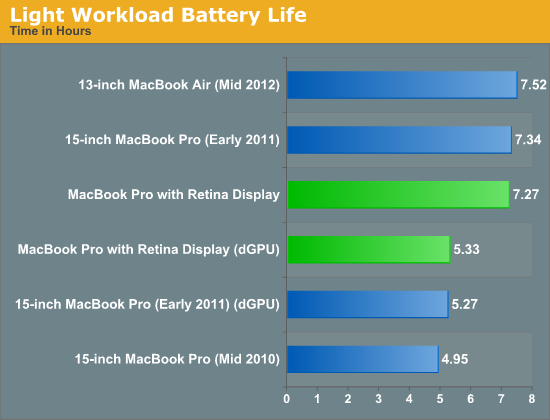
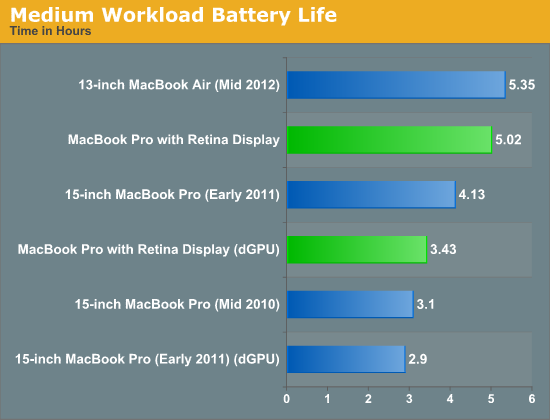
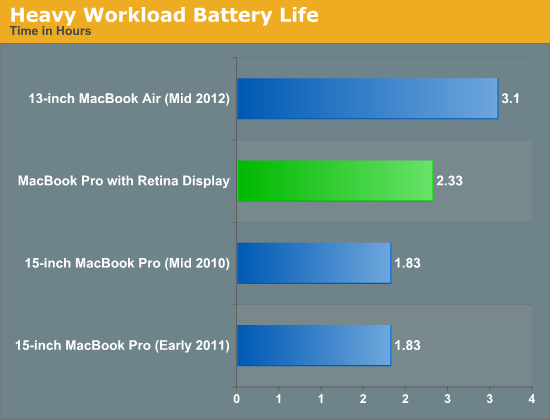
Overall the rMBP pretty much behaves as expected. Apple claims up to 7 hours of battery life and using our light workload we see a bit over that. Fire up the dGPU and even a light workload will get cut down to around 5.5 hours. Moderate usage will drop battery life to around 5 hours, and if you fire up the dGPU you’ll see that cut down to 3.5. The heavy multitaskers in the audience will see a bit above 2 hours out of a single charge. Note that all of these numbers are at 100 nits, drive the 2880 x 1800 panel at its full brightness and you can expect a tangible reduction in battery life.
The rMBP’s integrated 95Wh battery is ginormous by today’s standards, but it’s really necessary to drive both the silicon and that impressive panel. Subjectively I did find the rMBP lasted longer than last year’s MacBook Pro, despite the similar max battery life ratings. My experiences were echoed by the results in our tests.
I suspect most users will see around 5 hours of battery life out of the system compared to a bit under 4 hours out of last year’s machine. At minimum brightness, typing a long document (similar to what I’m doing right now) you can significantly exceed Apple’s 7 hour estimate. As always it really depends on usage model. Professional users doing a lot of photo and video editing aren’t going to see anywhere near the max battery life, while the writers and general users will be quite happy.
One trick to maximizing battery life on light or moderate workloads is to keep an eye on what the discrete GPU is doing. I still find that OS X will wake up the discrete GPU far too frequently, even when in my opinion its services aren’t needed. As always I turn to Cody Krieger’s excellent gfxCardStatus app for keeping an eye on which GPU is driving the panel. The app has been updated and is now fully compatible with the rMBP.


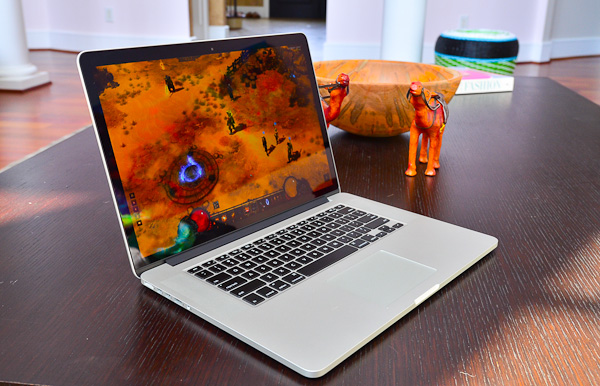
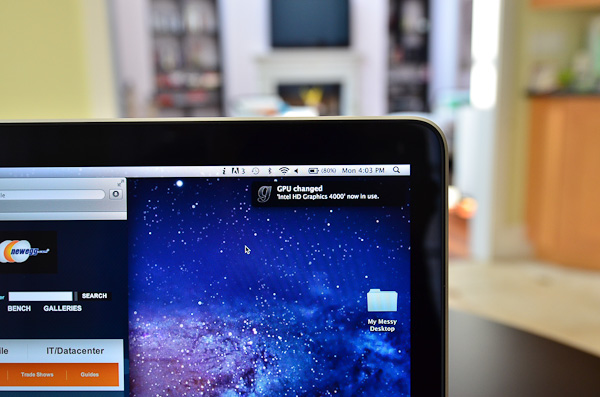








471 Comments
View All Comments
seapeople - Sunday, June 24, 2012 - link
Wow, is that the Sony everyone here has been harping about "outdoing Apple" years ago?Reading that review basically says that while the general specs of that Sony are outstanding, every other possible aspect of user experience (keyboard, hinge design, trackpad, thermals, and noise) is completely terrible.
Oh, and it looks like it costs more than the rMBP and comes loaded with bloatware.
There's a reason that didn't get an Editor's choice award, and it's not some great conspiracy...
OCedHrt - Monday, June 25, 2012 - link
Not really. You can buy it without the bloatware, you just need to select Windows Pro. They got a review unit from Sony, and Sony shipped them their "consumer" version which is loaded with bloatware (although I agree, that is even more reason to not have bloatware).The hinge is by design and something Sony engineers are quite proud of. Not everyone likes it when something is different, especially when it comes to keyboards.
Simply read the comments (http://www.anandtech.com/Show/Index/5530?cPage=5&a... and you can see only the reviewer had an issue with the hinge that he couldn't even explain very well.
I have been using the Z1 for 2 years now and the experience is awesome. It may just take some time to get used to a small laptop.
Trackpad can glitch every once in a while and for noise you can make it silent in the Sony control center (change fan from performance to silent).
There is always going to be fan noise in a high end laptop when stressing the system. This applies to the rMBP as well (http://forums.macrumors.com/showthread.php?t=13918...
Spunjji - Tuesday, June 26, 2012 - link
Moron.mlambert890 - Thursday, November 29, 2012 - link
Were you two on the design team of the Z? LOL!You just called the guy a moron for pointing out why *ANAND* didnt like the Z.
OK you guys are right. The Z is amazing and it is a crime against humanity that only you and your fellow crusader "get it". Sony should be the #1 PC maker rather than approaching junk bond status and it is only Apples "marketing hype" their ability to "buy off" guys like Anand and the "stupidity" of everyone on earth (except you two) that keeps Apple profitable. What an amazingly arrogant pile of crap that is
Im a huge Vaio fan and Im 100% sure Ive spent more on them than you two have combined over the years and even *I* think the two of you sound nuts.
UltraTech79 - Saturday, June 23, 2012 - link
You're talking out your ass.KoolAidMan1 - Saturday, June 23, 2012 - link
Amazing argument.Truth hurts dude, sorry
KoolAidMan1 - Saturday, June 23, 2012 - link
Nothing you noted is cutting edge, and it is also thicker and heavier than Apple's machinesOCedHrt - Sunday, June 24, 2012 - link
How is 2.5 lbs and 0.66" thick thicker and heavier than Apple's machines? Apple does not have a single laptop lighter and thinner than Sony's Z. Not even the ridiculously slow MBA can compete.KoolAidMan1 - Monday, June 25, 2012 - link
Since when were Ivy Bridge i5 and i7 CPUs ridiculously slow?Spunjji - Tuesday, June 26, 2012 - link
Comparatively? Since forever. Stop trying to undermine people's valid arguments by failing to read them, jackass.